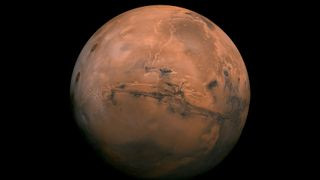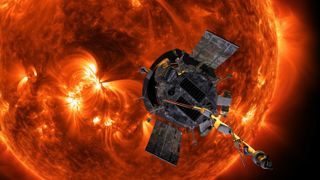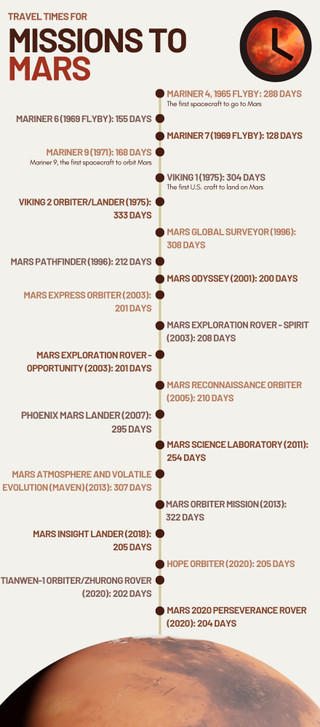Have you ever gazed at the night sky and wondered about the journey to Mars? The Red Planet, our intriguing neighbor, has captivated human imagination for centuries. While a one-way trip to Mars is estimated to take around nine months, a round trip could extend to approximately three years. But what exactly determines the duration of this interplanetary voyage?
These timeframes are just ballpark figures. The actual travel time to Mars is a complex equation influenced by a multitude of factors. The ever-changing distance between Earth and Mars, dictated by their orbital paths, and the sophistication of spacecraft propulsion technology are key determinants. In this article, we’ll break down the mechanics of Mars travel using current technology and explore the variables that impact the length of this incredible journey.
Understanding the Distance to Mars: A Variable Journey
To understand the duration of a Mars mission, we first need to grasp the fluctuating distance between our two planets.
Mars is the fourth planet from the sun and Earth’s second closest planetary neighbor, with Venus being the closest. However, the distance separating Earth and Mars is not constant; it changes continuously as both planets journey around the sun in their respective orbits.
The closest Earth and Mars could theoretically get to each other occurs when Mars is at its perihelion (closest point to the sun) and Earth is at its aphelion (farthest point from the sun). In this hypothetical scenario, they would be approximately 33.9 million miles (54.6 million kilometers) apart. However, this precise alignment has never been recorded. The closest recorded approach happened in 2003, with a distance of 34.8 million miles (56 million km).
Conversely, the planets are at their maximum separation when both are at their aphelion, positioned on opposite sides of the sun. At this point, the gulf between them can widen to a staggering 250 million miles (401 million km).
On average, the distance between Earth and Mars is around 140 million miles (225 million km).
Related read: What is the temperature on Mars?
Mars Travel Time at Light Speed: A Matter of Minutes
 Image of Mars against the black backdrop of space. The planet is a rusty red color.
Image of Mars against the black backdrop of space. The planet is a rusty red color.
Light, the fastest entity in our universe, travels at an astonishing speed of approximately 186,282 miles per second (299,792 km per second). If we could hypothetically send a beam of light from Mars to Earth, or vice versa, here’s how long it would take to bridge the gap:
- Closest Possible Approach: 182 seconds, or 3.03 minutes
- Closest Recorded Approach: 187 seconds, or 3.11 minutes
- Farthest Approach: 1,342 seconds, or 22.4 minutes
- Average Distance: 751 seconds, or just over 12.5 minutes
This exercise highlights the immense distances involved in space travel, even at the speed of light.
Travel Time to Mars Using the Fastest Spacecraft: Days, Not Months
NASA’s Parker Solar Probe currently holds the record for the fastest spacecraft, consistently breaking its own speed records. On December 24, 2024, it achieved a peak velocity of 430,000 miles per hour (692,000 km per hour) during its solar flyby.
 Graphic illustration shows the Parker Solar Probe in front of the blazing sun.
Graphic illustration shows the Parker Solar Probe in front of the blazing sun.
Imagine if we could repurpose the Parker Solar Probe for a direct journey to Mars. Traveling at its peak speed, here’s the theoretical travel time:
- Closest Possible Approach: 78.84 hours (3.3 days)
- Closest Recorded Approach: 80.93 hours (3.4 days)
- Farthest Approach: 581.4 hours (24.2 days)
- Average Distance: 325.58 hours (13.6 days)
While these times are significantly shorter than light travel, they are still theoretical. The Parker Solar Probe is designed for solar research and its trajectory is not optimized for Mars travel.
Expert Insights: Factors Affecting Mars Mission Duration
To delve deeper into the complexities of Mars travel time, we consulted Michael Khan, a Senior Mission Analyst at the European Space Agency (ESA).
Michael Khan explains that mission duration is fundamentally linked to energy expenditure. “The time it takes to get from one celestial body to another depends largely on the energy that one is willing to expend,” he states. “In space travel, everything boils down to energy. Spaceflight is the clever management of energy.” This energy encompasses the power of the launch vehicle and the spacecraft’s onboard rocket maneuvers and propellant usage.
For lunar missions, common transfer methods include the Hohmann transfer, known for its energy efficiency under specific conditions, and the Free Return Transfer. However, Mars missions, being interplanetary, involve orbits around the sun, adding complexity.
Khan highlights the “pork chop plot,” a crucial tool for trajectory experts. This diagram illustrates optimal departure and arrival dates for Mars transfers, along with the energy requirements. Pork chop plots reveal that Mars transfer opportunities occur roughly every 25-26 months. These opportunities are further categorized into faster (5-8 months) and slower (7-11 months) transfers. While faster options exist, slower transfers often prove more energy-efficient.
“A rule of thumb is that the transfer to Mars takes around as long as the human period of gestation, approximately 9 months. But that really is no more than an approximate value,” Khan clarifies. Precise calculations are always necessary for specific launch dates.
Why Orbiting or Landing Missions Take Longer
Missions designed to orbit or land on Mars inherently have longer travel times compared to flyby missions. Khan explains that achieving orbit or landing introduces significant constraints. Orbiters require substantial propellant for orbit insertion, while landers necessitate robust heat shields to withstand atmospheric entry. These factors limit the permissible arrival velocity at Mars.
“Adding this constraint to the trajectory optimisation problem will limit the range of solutions you obtain to transfers that are Hohmann-like. This usually leads to an increase in transfer duration,” Khan notes.
The Curvature of Space Travel: Beyond Straight Lines
Previous calculations often simplify the distance between Earth and Mars as a straight line. However, this is misleading. A direct straight line path through the farthest planetary positions would pass directly through the sun, an impossible trajectory for spacecraft. Spacecraft must follow orbital paths around the sun.
Even for closer approaches, assuming a constant planetary distance during the entire journey is inaccurate. In reality, Earth and Mars are in constant motion at varying speeds in their solar orbits. Mission engineers must precisely calculate trajectories, anticipating Mars’ future position when the spacecraft arrives, rather than targeting its position at launch. This is akin to aiming at a moving target from a moving vehicle.
Furthermore, maximizing speed isn’t always the goal. Spacecraft intended to orbit or land must decelerate upon arrival to execute orbit insertion maneuvers. Arriving too fast would make capturing the spacecraft into Martian orbit impossible.
Ultimately, travel time to Mars is also intrinsically linked to advancements in propulsion technology.
NASA’s Goddard Space Flight Center indicates that an optimally aligned launch to Mars would result in a journey of approximately nine months. Physics professor Craig C. Patten from the University of California, San Diego, explains the orbital mechanics:
“It takes the Earth one year to orbit the sun and it takes Mars about 1.9 years (say 2 years for easy calculation) to orbit the sun. The elliptical orbit which carries you from Earth to Mars is longer than Earth’s orbit but shorter than Mars’ orbit. Accordingly, we can estimate the time it would take to complete this orbit by averaging the lengths of Earth’s orbit and Mars’ orbit. Therefore, it would take about one and a half years to complete the elliptical orbit. In the nine months it takes to get to Mars, Mars moves a considerable distance around in its orbit, about three-eighths of the way around the sun. You have to plan to make sure that by the time you reach the distance of Mars’ orbit, Mars is where you need it to be! Practically, this means that you can only begin your trip when Earth and Mars are properly lined up. This only happens every 26 months. That is, there is only one launch window every 26 months.”
While shorter trips are theoretically possible by burning more fuel, current technology and mission constraints often prioritize efficiency.
Future Propulsion Technologies: Cutting Down Travel Time
Technological advancements promise to drastically reduce Mars travel times in the future. NASA’s Space Launch System (SLS), a powerful new rocket, is poised to become the workhorse for future deep-space missions, including crewed Mars missions.
More radically, concepts like photon propulsion could revolutionize interplanetary travel. Philip Lubin, a physics professor at the University of California, Santa Barbara, and his team are developing Directed Energy Propulsion for Interstellar Exploration (DEEP-IN). This system utilizes powerful lasers to propel spacecraft to velocities approaching the speed of light. Lubin suggests that DEEP-IN could potentially send a 220-lb. (100 kilograms) robotic spacecraft to Mars in a mere three days.
“There are recent advances which take this from science fiction to science reality,” Lubin stated at the 2015 NASA Innovative Advanced Concepts (NIAC) fall symposium. “There’s no known reason why we cannot do this.”
Historical Mars Missions: A Timeline of Journeys
 Timeline of missions to Mars.
Timeline of missions to Mars.
Looking at past Mars missions provides a real-world perspective on travel times. The infographic above and the list below detail the duration of several historical missions to the Red Planet, including their launch dates:
Here is a list of how long it took several historical missions to reach the red planet (either orbiting or landing on the surface). Their launch dates are included for perspective. (Image credit: Future)
(Note: The original article includes an infographic image here, which is represented above. For a text-based representation, a table or list summarizing mission names, launch dates, and travel times could be added here if desired to further enhance the article.)
Further Exploration
To delve deeper into Mars exploration, explore these resources:
- NASA’s Moon to Mars Overview: Moon to Mars overview – Learn about NASA’s broader plans for lunar and Martian exploration.
- The Conversation: How to get people from Earth to Mars and safely back again: The Conversation – An informative article discussing the complexities of crewed Mars missions and return journeys.
- Nature Research Paper on Human Health Risks: research paper – Understand the potential health challenges of long-duration Mars missions.
Conclusion: The Journey to Mars – A Balancing Act of Time and Technology
The question of “How Long Does It Take To Travel To Mars?” doesn’t have a simple answer. It’s a complex interplay of planetary positions, orbital mechanics, and propulsion technology. While current missions typically take around nine months for a one-way trip, this duration is subject to various factors and mission objectives.
As technology advances, particularly in propulsion systems, the dream of shorter Mars journeys is becoming increasingly tangible. Future missions may leverage innovations like the SLS rocket and potentially even revolutionary concepts like photon propulsion to significantly reduce travel times, paving the way for more efficient and ambitious Mars exploration endeavors. The journey to Mars, while challenging, remains a captivating frontier pushing the boundaries of human ingenuity and our reach among the stars.
